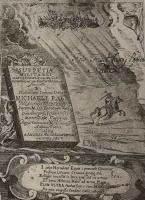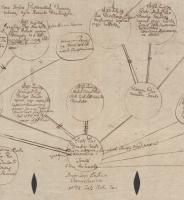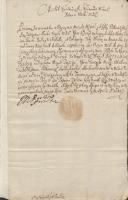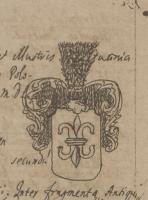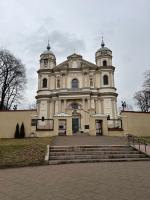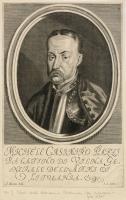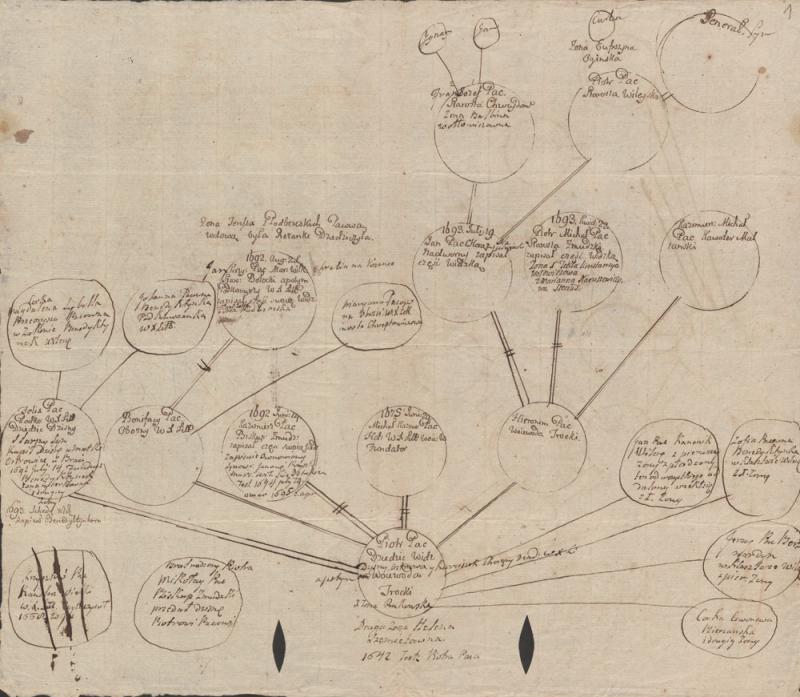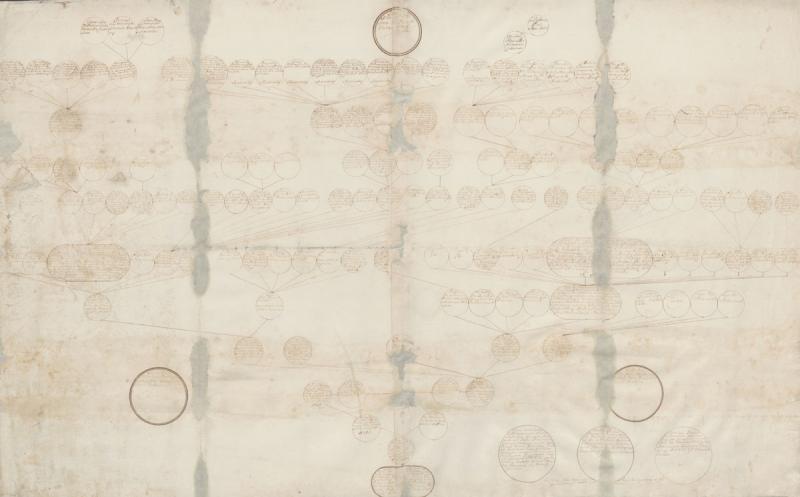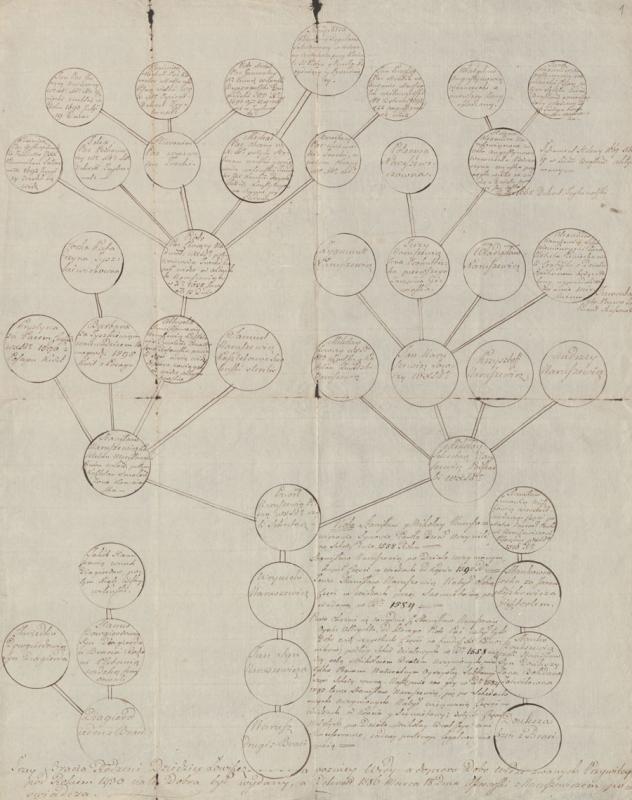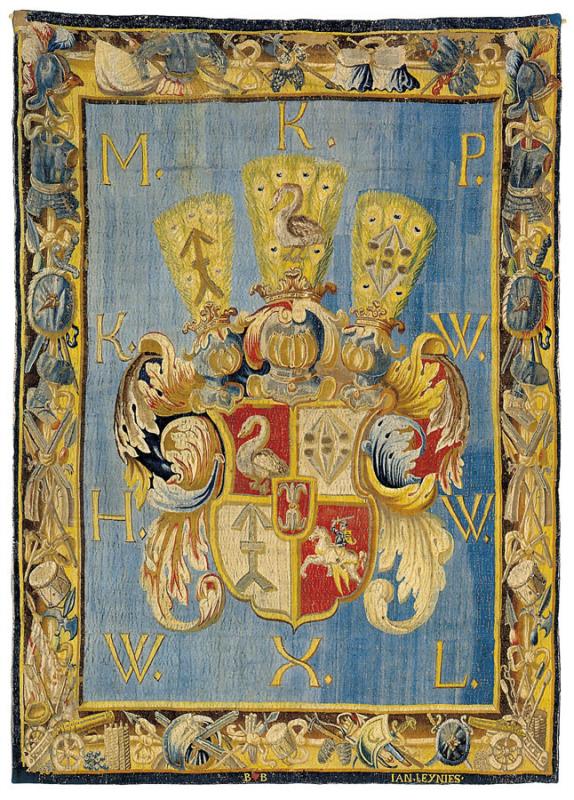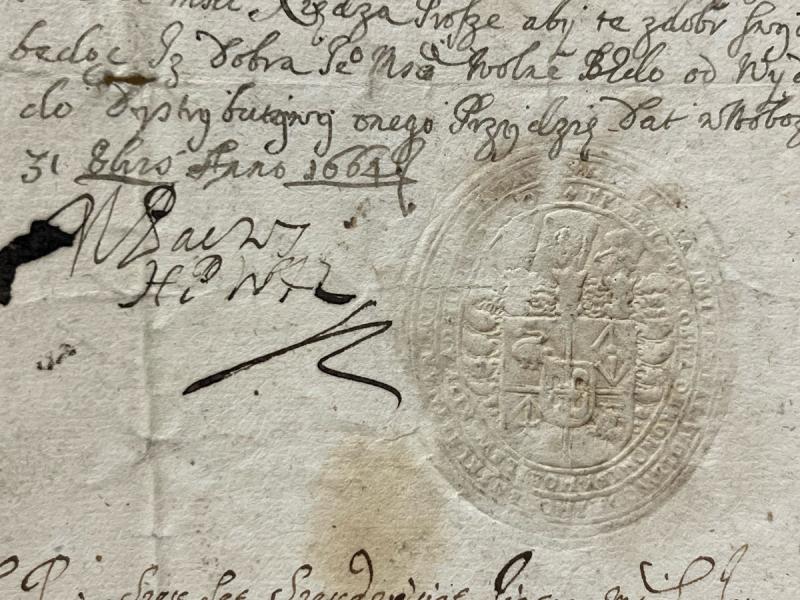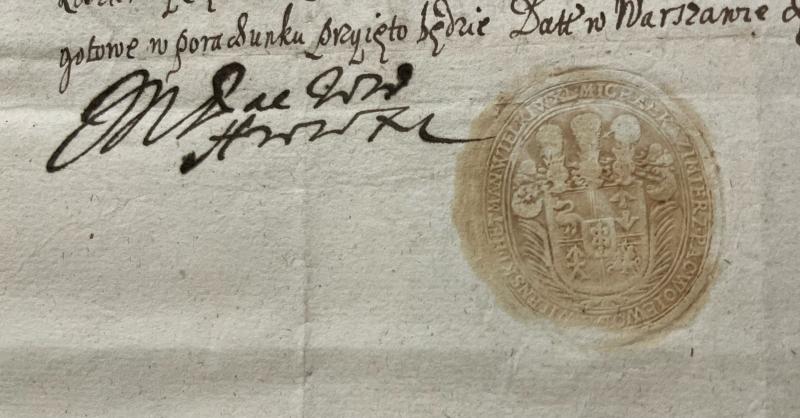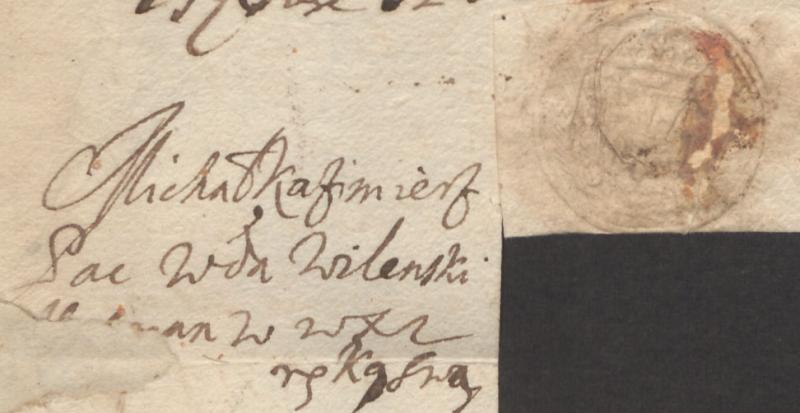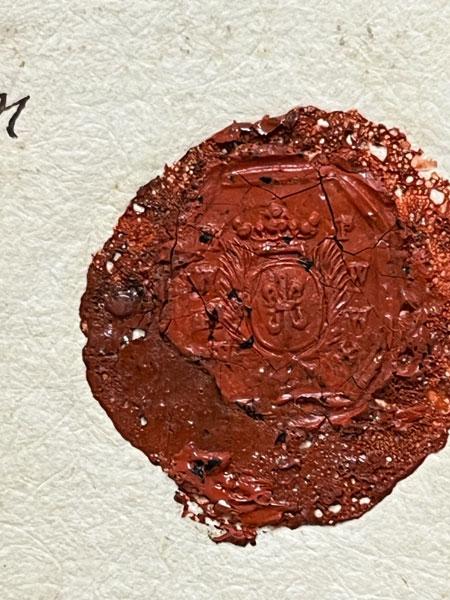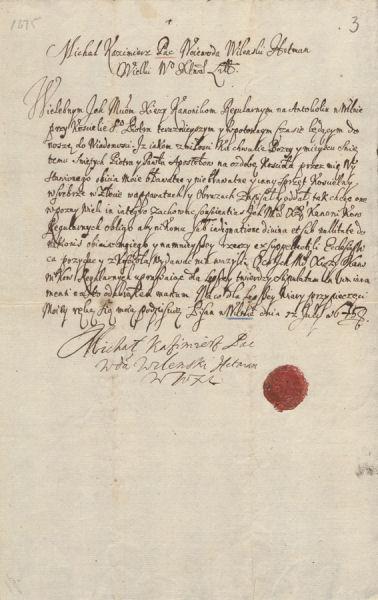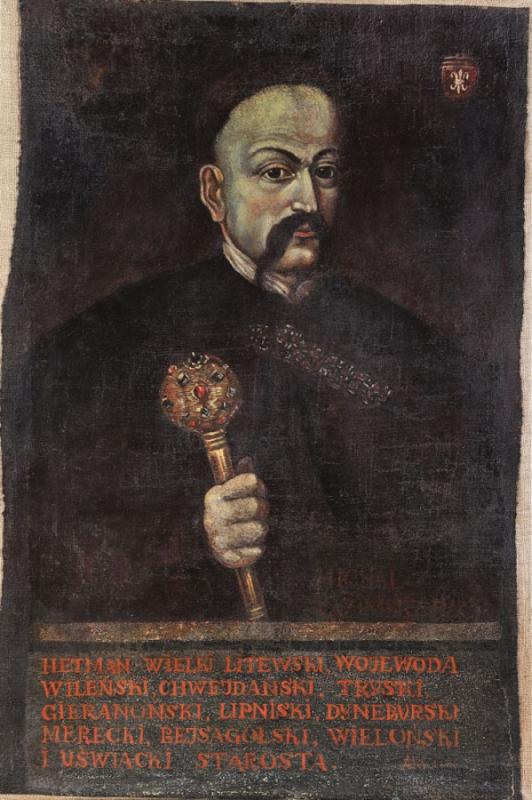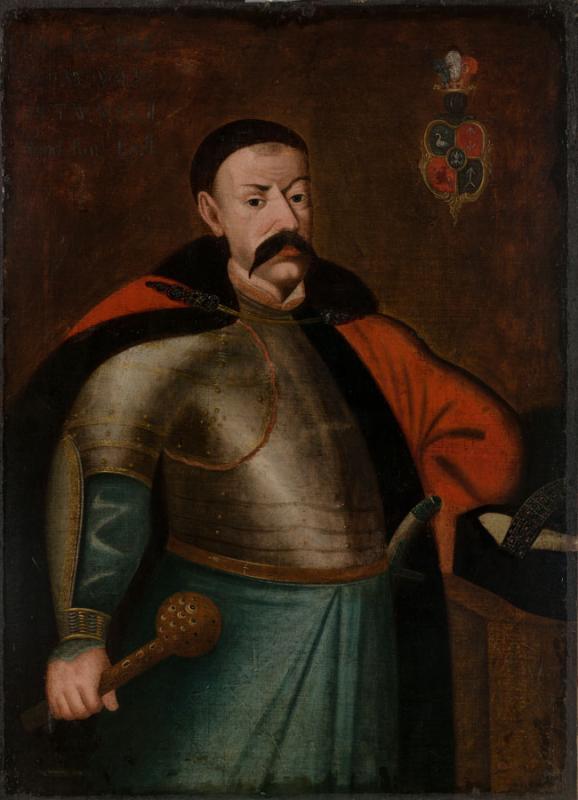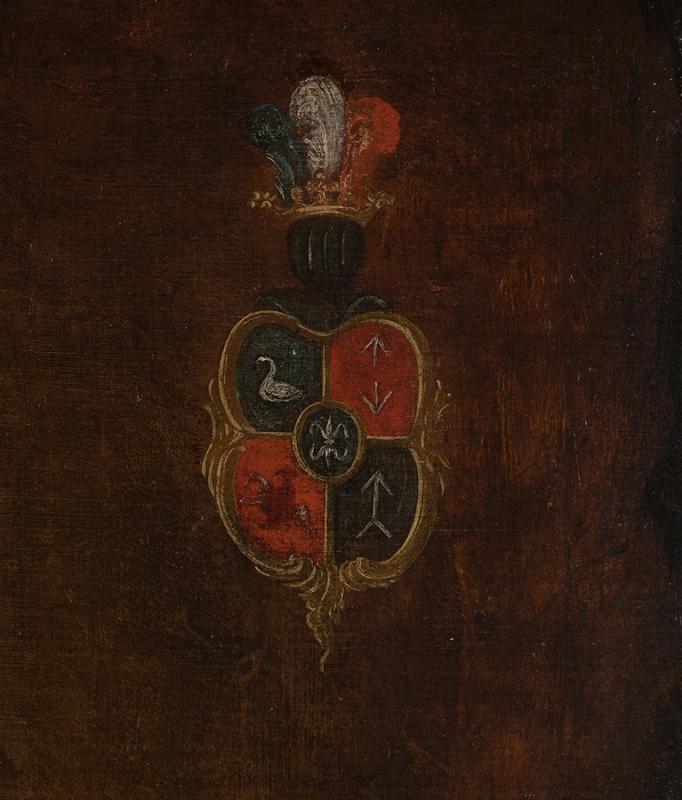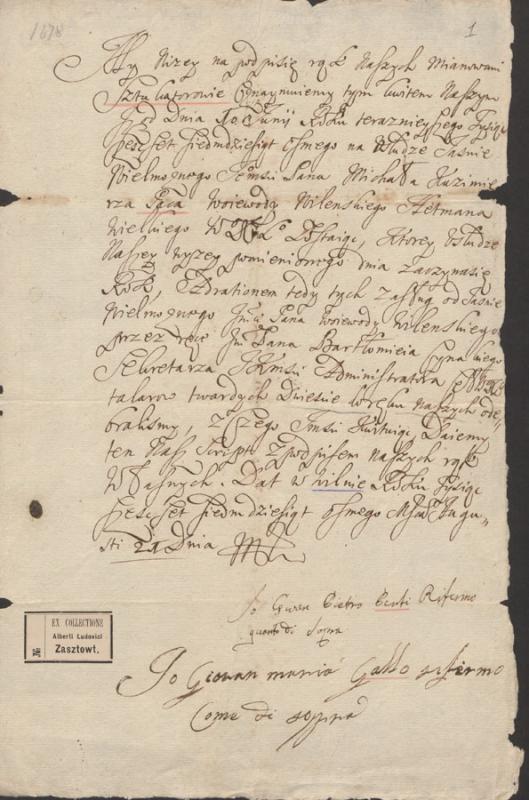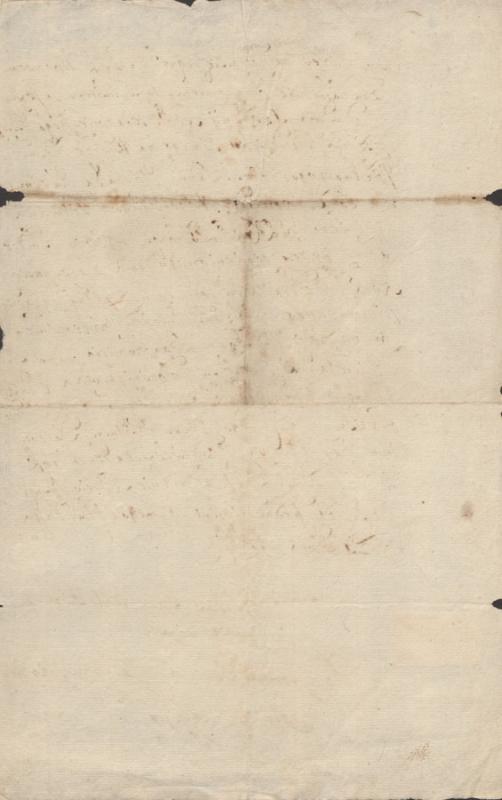Genealogical trees, heraldry, seals and paintings related to Mykolas Kazimieras Pacas
The genealogical trees of the Pacas family are undoubtedly unique documents. The Pacas family created a myth about their Italian origin, inventing relations to a Pazzi family of Florence. But what story do their family trees tell? The Wroblewski Library holds the Pacas family genealogical chart draft from the early 18th century, the finalized 18th century Pacas family genealogical chart, and the genealogical tree of the Pacas family.
As the research of Agnė Railaitė-Bardė shows, “in the genealogical chart draft of the Pacas family \ one can distinguish three different entries. It shows that the document was edited twice. <...> Additions to the genealogical chart draft were made shortly after its creation”. The author did not conduct more detailed research about how Mykolas Kazimieras Pacas was described in these charts and trees, however, this was not the object of her research.
For more see: Railaitė-Bardė, Agnė. Origo et arma: kilmė ir herbas Lietuvos Didžiojoje Kunigaikštystėje XVI–XVIII a. Vilnius: Lietuvos istorijos institutas, 2020, p. 93–94.
But how Mykolas Kazimieras Pacas is described in this draft chart? One entry includes: 1675 Iuni: 29 Michal Kaz[i]mie[rz]: Pac Het[man]: W[ielkiego] X[ięstwa] Litt[ewskiego] Woie[wodztwa]: W[ilenskiego] Fundator (29th of Jue,1675: Mykolas Kazimieras Pacas, Grand Hetman of the Grand Duchy of Lithuania, Voivode of Vilnius and founder”).
The date of 1675 can be related to his will, made in the same year. In 1667, he became the Grand Hetman and in 1669, Voivode of Vilnius. “The founder” likely refers to the Church of the Apostles St. Peter and St. Paul in Vilnius which was founded by Mykolas Kazimieras Pacas.
It can be seen from this chart that the Pacas family showed prominent genealogical self-awareness. As the research of Dr. Railaitė-Bardė shows, “the tree does not stand out for its iconographic splendor, but the circles in which the genealogy of the family is written are not uniform. They differ in size and brightness. The legendary ancestors of the Pacas family are represented below in separate large circles which are not directly linked to the genealogical chart. Although it is noted that the genealogy of the legendary ancestors is not known completely, we learn from the information at hand about what kind of family history the Pacas family attributed to themselves. The genealogical chart indicates that, 3995 years after creation of the world, Cosmus Pacius, who had been Consul Romanus Pontifex Maximus together with his close relatives, Palemon Publius, Prosperus Caesarian Column, Dausprung and others, after the battle of Farsal, fearing a revenge of Julius, came from Rome to Lithuania. <...> The other two ancestors of the Pacas family (also not directly linked to the genealogical chart itself) are represented by large, highlighted circles <...>. They are Vilhelmas Pacas <...> and Steponas Pacas. However, the most prominent figure, placed at the very top of the document, is Marija Magdalena de Pazzi from Florence, who is also not directly included in the genealogical chart.
For more see: Railaitė-Bardė, Agnė. Origo et arma: kilmė ir herbas Lietuvos Didžiojoje Kunigaikštystėje XVI–XVIII a. Vilnius: Lietuvos istorijos institutas, 2020, p. 107–108.
Let us pay attention to how Mykolas Kazimieras Pacas is described in the genealogical chart: Michal Pac W[oiewo]da Wilenski Hetman W[ielki] W[ielkiego] K[sięstwa] L[itewskiego] z Szemiothowny (“Mykolas Pacas, Voivode of Vilnius, Grand Hetman from Šemetaitė”). His mother was Elžbieta Šemetaitė.
The genealogical tree of the Naruševičius and Pacas families depicts nine generations, three of which are of the Pacas family (in the branch of Stanislovas Naruševičius).
For more see: Railaitė-Bardė, Agnė. Origo et arma: kilmė ir herbas Lietuvos Didžiojoje Kunigaikštystėje XVI–XVIII a. Vilnius: Lietuvos istorijos institutas, 2020, p. 107–108.
In this genealogical tree, the offices of M. K. Pacas are described in more detail: Michal Pac obozny W: X: Lt; potym hetman wielki y woiewoda wilenski fundator [...] Kanon: Regula Latter: Konstytucyja na Seymie wyiednal (“Mykolas Pacas, Field Camper, later Grand Hetman and Voivode of Vilnius, [...] founder of the Canons Regular of the Lateran Monastery [...]”).
In conclusion, we can say that the family genealogical charts and trees name Mykolas Kazimieras Pacas differently. Although his offices as Grand Hetman and Voivode of Vilnius are emphasized, in some documents they are mentioned alongside other offices, origins (from Šemetaitė) and patronage.
Lietuvos nacionalinis muziejus, LNM IM 2555
At the heart of the coat of arms, there is the double lily coat of arms of the Pacas family. The first field shows the “Swan” coat of arms (in Polish Łabędź), belonging to Mykolas Kazimieras Pacas’ mother Elžbieta Šemetaitė, who inherited it from her father Vaclovas Šemeta. The second field shows the coat of arms “Bogoria”, belonging to his paternal grandmother Regina Valavičiūtė, which depicts two spearheads facing away from each other. The third field shows the coat of arms (in Polish Kościesza) belonging to Pacas’ maternal grandmother Elžbieta Chodkevičiūtė, inherited from father Jurgis Chodkevičius ), which depicts a crossed arrow with a bifurcated tail. The fourth part shows the coat of arms “the Rider”, belonging to Pacas’ maternal great-grandmother Sofija Sluckaitė. Above the joint coat of arms shield, there are three helmets with medallions on their necks, topped by little crowns. Above them there are peacock feathers. The left-most helmet includes ornaments of the “Bogoria” coat of arms figure: two spearheads, with a swan in the middle, and on the right, the figure of the coat of arms Kościesza – a crossed arrow with with a bifurcated tail. Around the coat of arms, the initials: M[ICHAŁ] K[AZIMIERZ] P[AC] K[ASZTELAN] W[ILEŃSKI] H[ETMAN] W[IELKI] W[IELKIEGO] K[SIĘSTW]A L[ITEWSKIEG]O (Mykolas Kazimieras Pacas, Castellan of Vilnius, Grand Hetman of the Grand Duchy of Lithuania).
A document from 1664 shows an imprint of a composite 5-field coat of arms seal. In the heart of the coat of arms (in the fifth field, in the centre of the coat of arms), there is the double lily coat of arms of the Pacas family. The first field shows the “Swan” coat of arms (in Polish Łabędź), belonging to Mykolas Kazimieras Pacas’ mother Elžbieta Šemetaitė, who inherited it from her father Vaclovas Šemeta. The second field displays the coat of arms “Bogoria”, belonging to his paternal grandmother Regina Valavičiūtė – it depicts two spearheads facing away from each other. The third field features the coat of arms (in Polish Kościesza), belonging to Pacas’ maternal grandmother Elžbieta Chodkevičiūtė, inherited from father Jurgis Chodkevičius), which depicts a crossed arrow with a bifurcated tail. The fourth field shows the coat of arms “the Rider”, belonging to Pacas’ maternal great-grandmother Sofija Sluckaitė. Above the composite coat of arms shield there are three barred helmets with medallions on their necks. Above the helmets are little crowns, topped with peacock feathers. The left-most helmet includes a figure from the “Bogoria” coat of arms: two spearheads. The sides of the composite coat of arms are surrounded by a cloak of acanthus leaves. Inscribed in the seal: M[ICH]AŁ KAZIMIERZ PAC WOIEWODA SMO[EN]SKI. In the inner legend: TR[...]SKI STAROSRA [....]KONOM MOH[...] ADM[...] (“Mykolas Kazimieras Pacas, Voivode of Smolensk. Elder of Tryškiai. Mogilev economy manager (administrator)”. The seal is oval, size 56 x 48 cm.
Moreat: Jasiūnienė, Gabrielė. Pacų heraldikos tradicija ir giminės didybės atspindžiai XVII a. antrojoje pusėje. From: Kauno istorijos metraštis, 2022, [t.] 20, p. 7–18.
The exceptional seal of Mykolas Kazimieras Pacas tells a truly interesting tale about the history of this family. A document from 1681 shows an imprint of a similar joint 5-field coat of arms seal. In the heart of the coat of arms, there is the double lily coat of arms of the Pacas family. The first part shows the “Swan” coat of arms (in Polish Łabędź), belonging to Mykolas Kazimieras Pacas’ mother Elžbieta Šemetaitė, who inherited it from her father Vaclovas Šemeta. The second field shows the coat of arms “Bogoria”, belonging to his paternal grandmother Regina Valavičiūtė, which depicts two spearheads facing away from each other. The third field features the coat of arms (in Polish Kościesza), belonging to Pacas’ maternal grandmother Elžbieta Chodkevičiūtė, inherited from father Jurgis Chodkevičius ), which depicts a crossed arrow with a bifurcated tail. The fourth field shows the coat of arms “the Rider”, belonging to Pacas’ maternal great-grandmother Sofija Sluckaitė. Above the joint coat of arms shield there are three barred helmets with medallions on their necks. Above the helmets are little crowns. Above them there are peacock feathers. The left-most helmet includes ornaments of the “Bogoria” coat of arms figure: two spearheads. The sides of the joint coat of arms are surrounded by a cloak of acanthus leaves. Inscription in the seal: MICHAŁ KAZIMIERZ PAC WOIEWODA WILENSKI HETMAN WIELKI W[IELKIEGO] K[SIĘSTW]A L[ITEWSKIEG]O (“Mykolas Kazimieras Pacas, Castellan of Vilnius, Grand Hetman of the Grand Duchy of Lithuania). The seal is oval, its size is 46 x 41 cm. The document is also unique because it contains Mykolas Kazimieras Pacas’s signature, which is found near the seal: M[ICHAŁ] PAC W[OIEWODA] W[ILENSKI] H[ETMAN] W[IELKI] W[IELKIEGO] K[SIĘSTW]A L[ITEWSKIEG]O.
More about the helardry of the Pacas family: Jasiūnienė, Gabrielė. Pacų heraldikos tradicija ir giminės didybės atspindžiai XVII a. antrojoje pusėje. From: Kauno istorijos metraštis, 2022, [t.] 20, p. 7–18.
LMAVB RS F20-912
This document contains a round seal, belonging to Mykolas Kazimieras Pacas. It depicts the coat of arms of the Pacas family – the double lily – within a rounded shield. Above the shield stands a 5-leaf crown: an allusion to his offices of Voivode of Vilnius and Grand Hetman of the Grand Duchy of Lithuania. On the sides of the seal, there are palm branches. Above the official crown, there is a letter M[ichał], which is an abbreviation of the name Mykolas, and on the right side of the shield there is the letter W[oiewoda], abbreviation of the office of voivode. Other letters are illegible due to the poor quality of the seal.
One may also pay attention to the signature: MICHAŁ KAZIMIERZ PAC W[OIEWO]DA WILENSKI HETMAN W[IELKI] W[IELKIEGO] K[SIĘSTW]A L[ITEWSKIEGO] reką swą. The signature is complete. The name is written in full (Mykolas Kazimieras Pacas), alongside the offices (Voivode of Vilnius, Grand Hetman of the Grand Duchy of Lithuania) and it is added that he signs “with his own hand”.
LMAVB RS F20-912
The document contains an eight-part signet seal of Mykolas Kazimieras Pacas in red wax. It depicts the coat of arms of the Pacas family, the double lily, inside an oval shield. Above the shield helmet there is a crown. There are palm branches on the sides of the shield. Initials around the coat of arms are as follows: M[ICHAŁ] P[AC] W[OIEWODA] W[ILENSKI] H[ETMAN] W[IELKI] W[IELKIEGO] K[SIĘSTWA] L[ITEWSKIEGO]. Mykolas Pacas, Voivode of Vilnius, Grand Hetman of the Grand Duchy of Lithuania.
Fotografas Mindaugas Kaminskas
The painting depicts Mykolas Kazimieras Pacas against a black background. The nobleman is dressed in a black cloak; in his left hand he holds the hetman’s scepter studded with jewels. The cloak is fastened with an elongated brooch, also studded with jewels. A white collar can be seen around his neck. Mykolas Kazimieras Pacas is depicted with a long, expressive mustache. The upper right corner of the picture features the coat of arms of the Pacas family, Gozdawa. An inscription is visible in the lower right corner: MICHAL / KAZIMERZ PAC. Below the portrait is a longer inscription: HETMAN WIELKI LITEWSKI, WOJEWODA WILEŃSKI, CHWEJDAŃSKI, TRYSKI, GIERANOŃSKI, LIPNISKI, DYNEBURSKI MERECKI, BEJSAGOLSKI, WIELOŃSKI I UŚWIACKI STAROSTA. / Ad 1682 (?).
Cited from: https://www.valdovurumai.lt/lt/savaites-eksponatai/i/464/mykolo-kazimiero-paco-portretas/
Lietuvos nacionalinis dailės muziejus, LNDM T-4462
In the representative portrait, the hetman is depicted standing at a table, turned toward the right by two thirds, his whole figure is visible down to his knees. He is dark-haired, with a mustache. He wears armor on a greenish-blue shirt and a red delia lined with black fur. The left-arm elbow is bent, with the hand placed on the waist, while his right hand holds the hetman’s scepter. A fur-trimmed hat is placed on a table covered with a brown tablecloth. A brown background is devoid of any other objects. The top right corner shows the coat of arms of the hetman, while the top left contains an inscription: MICHAL PAC WOIEW: WILN: HET: W: W: X: L: FUND: KAN: LATT. The portrait was described by Dalia Tarandaitė.
In the composite coat of arms featured in the painting, the fifth (dark-blue and oval-shaped) field shows the double lily coat of arm of the Pacas family. The first, dark blue part shows a silver swan – the coat of arms of the Šemeta family, “the Swan”. In the second, red part there are two golden spearheads facing away from each other – the coat of arms of the Valavičius family, “Bogoria”. It must be noted, that in the previously discussed tapestry and seals from the 17th century, the third field of the composite coat of arms carried the coat of arms Kościesza, belonging to the maternal grandmother of Mykolas Kazimieras Pacas, Elžbieta Chodkevičiūtė. Instead, in this portrait, the third, red field is occupied by the coat of arms “Rider”, belonging to the maternal great-grandmother of Pacas, Sofija Sluckaitė. Presumably, the coat of arms of the more influential Sluckas family is given a more honorable place in the composite coat of arms. The fourth, blue field features a silver arrow with a bifurcated tail. This is likely an attempt to depict the coat of arms Kościesza, however without the crossbar. The composite coat of arms is painted in a cartouche with gold edges. The shield is topped by a dark blue barred helmet with a little golden crown above it. The helmet is decorated by three ostrich feathers. The heraldic left is in the colour red, the middle is in white (silver), the heraldic right is in blue.
Lietuvos nacionalinis dailės muziejus, LNDM G-36304
This graphics artwork depicts the Grand Hetman of the Grand Duchy of Lithuania, Mykolas Kazimieras Pacas (1624–1682). The nobleman’s portrait is placed in an oval shape, under which there is an inscription: MICHELE CASIMIRO PAZZI PALATINO DI VILNA GENERALE DELL’ ARMI DI LITUANIA &c.
Engraving from: Gualdo Priorato, Galeazzo. Historia di Leopoldo Caesare. P. 3. In Vienna d’Austria: Appresso Giovanni Battista Hacque, insert between pages 144 and 145.
LMAVB RS F20-932
This receipt confirms that Mykolas Kazimieras Pacas, Voivode of Vilnius, Grand Hetman of the Grand Duchy, paid some plasterers 200 thalers for their services. The receipt comes with the signatures of the plasterers.

